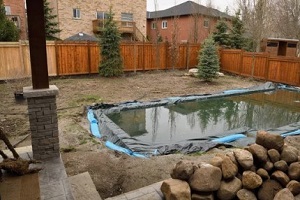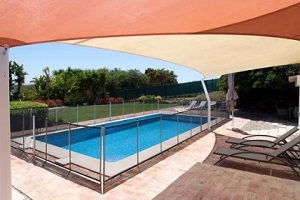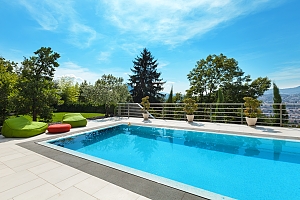 If you are planning to install a pool in Maryland, there are some legal requirements that must be met including state regulations to ensure the safety of pool users and to prevent potential construction accidents. Here’s what you need to know about obtaining a pool installation permit in Maryland.
If you are planning to install a pool in Maryland, there are some legal requirements that must be met including state regulations to ensure the safety of pool users and to prevent potential construction accidents. Here’s what you need to know about obtaining a pool installation permit in Maryland.
Maryland Pool Installation Permit Requirements
Before you are able to begin building your pool, your licensed pool installation company will obtain a permit from your local city or county government. The purpose of the permit is to ensure that the pool is constructed in accordance with all necessary safety regulations and zoning codes. To register for a pool installation permit in Maryland, they will submit an application to your local county or city government office.
The pool permit application will typically require the builder to provide detailed information about the proposed pool installation, including the size and location of the pool, fencing and safety features, electrical requirements, and drainage plans. The pool company may also need to provide plans and drawings of the proposed pool installation, as well as any necessary engineering or structural certifications.
It’s important to note that the pool installation permit process can be lengthy; beginning the process as soon as possible can help to avoid any unnecessary delays.
Pool Safety Features
In order to obtain a pool installation permit in Maryland, the builder is required to include a number of safety features in your pool design such as fencing around the pool area, a pool cover, and a pool alarm. These legal safety features are designed to prevent accidents and make sure that your pool is as safe as possible for swimmers.
Fencing Requirement
In Maryland, pool fencing is required to be at least 48 inches high and have a self-closing, self-latching gate in order to prevent any children from entering without supervision. Fencing must also be located at least 20 inches away from the edge of the pool, and any gaps in the fence must be no more than 4 inches wide.
Electrical Requirements
 In addition to the safety features and fencing requirements included in your pool design, there will also be specific electrical requirements implemented. These will ensure compliance with electrical codes in place to ensure the safety and functionality of your pool.
In addition to the safety features and fencing requirements included in your pool design, there will also be specific electrical requirements implemented. These will ensure compliance with electrical codes in place to ensure the safety and functionality of your pool.
Maryland Electrical Code
In Maryland, the electrical code requires that all pool electrical systems be installed by a licensed electrician. This will include the installation of wiring for pool pumps, lights and heaters. Your electrician must ensure that all of the wiring is properly grounded and that all electrical components are installed in such a way that meets the necessary safety requirements.
Additional electrical pool requirements may include items such as installation of a ground-fault circuit interrupter (GFCI) outlet and a pool bonding grid, which are in place to prevent electrical accidents and ensure that your pool is as safe as possible for swimmers.
Drainage Requirements
It’s essential to have a drainage system that abides by state code. The drainage system of your pool is responsible for removing excess water and preventing standing water, which can be a breeding ground for mosquitoes and other insects. In Maryland, there are specific regulations in place to ensure that your pool’s drainage system does not create a health safety issue.
Maryland Drainage Regulations
A successful drainage system is designed to ensure that the pool area and the surrounding property are not flooded. To meet Maryland’s drainage regulations, the following aspects of your pool’s drainage system must meet code elements:
- Drainage Grading: The land grade of the pool’s drainage system should slope away from the pool and toward an appropriate drainage outlet or sewer. A proper slope will prevent standing water and flooding around the pool.
- Multiple Drainage System Components: The drainage system should consist of a primary and secondary drain. The primary drain is responsible for removing the majority of water from the pool. The secondary drain acts as a backup in case the primary drain is at capacity or becomes clogged.
- Drainage Outlet: A proper drainage outlet will be designed to prevent clogging and allow for the flow of water away from the pool.
- Overflow Drain: The overflow drain is designed to prevent water from spilling over the pool’s edge during heavy rain or when the pool is filled to capacity.
Maryland Pool Inspection Process
 Your newly installed pool will be inspected by the county or city in which you live to ensure that it meets all of the necessary safety requirements. An inspector will check the depth and location of the pool in relation to other structures on your property, and confirm that the safety features meet code requirements.
Your newly installed pool will be inspected by the county or city in which you live to ensure that it meets all of the necessary safety requirements. An inspector will check the depth and location of the pool in relation to other structures on your property, and confirm that the safety features meet code requirements.
Contact the Maryland Pool Building Professionals
Building a pool in Maryland requires adherence to specific legal requirements; Masten Pools understands these requirements and is very familiar with the entire permit process! Guarantee that your pool is up to code and meets all of the necessary safety requirements by working with Masten Pools, the experienced and licensed Maryland pool building professionals.
Our pool building professionals will take care of the permit process, design a pool that meets all of the necessary safety requirements and your design goals, while ensuring that your pool is built to last. Contact Masten Pools today to schedule a no-cost on-site consultation and start building your dream pool!
